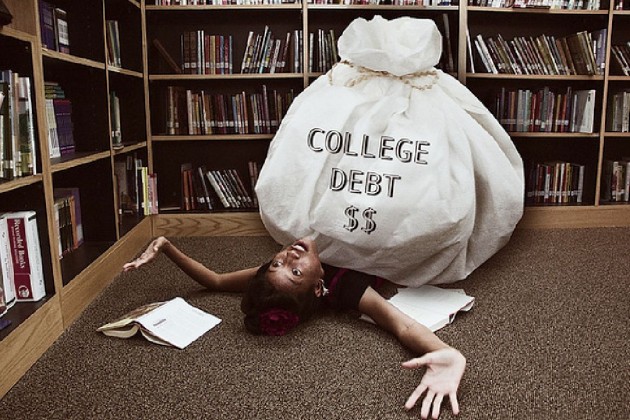Just when I think things can’t possibly get more idiotic and ridiculous, they do. As WSJ reports, tens of thousands (if not hundreds of thousands) of Americans are going back to school in order to take out student loans. Not for education, but to use them as their primary source of income. Once you think about it, it does make perfect sense and I do not blame the people trying to get whatever money they can in order to bridge their expense gap.
I guess this so called 6.6% unemployment is not working for everyone. I do blame the FEDs and the idiots at every level of our government. The situation we see today is the direct result of monetary policy implemented over the last 2 decades. Somehow, the fools believe that they can simply print money and insure that everything goes on as it should. Of course, it works until it doesn’t.
We have already experienced a number of sever bear markets since the 2000 top. With one more bear market and a severe recession left of the clock (2014-2017), it is my hope that the American people wake up and demand answers from their Government. But I will not be holding my breath. For most Americans, watching “The Biggest Loser” is a lot more important than understanding macroeconomic issues at hand. Oh well.
WSJ Writes: Student Loans Entice Borrowers More for Cash Than a Degree
Some Americans caught in the weak job market are lining up for federal student aid, not for education that boosts their employment prospects but for the chance to take out low-cost loans, sometimes with little intention of getting a degree.
Take Ray Selent, a 30-year-old former retail clerk in Fort Lauderdale, Fla. He was unemployed in 2012 when he enrolled as a part-time student at Broward County’s community college. That allowed him to borrow thousands of dollars to pay rent to his mother, cover his cellphone bill and catch the occasional movie.
“The only way I feel I can survive financially is by going back to school and putting myself in more student debt,” says Mr. Selent, who has since added $8,000 in student debt from living expenses. Returning to school also gave Mr. Selent a reprieve on the $400 a month he owed from previous student debt because the federal government doesn’t require payments while borrowers are in school.
A number of factors are behind the growth in student debt. The soft jobs recovery and the emphasis on education have driven people to attain more schooling. But borrowing thousands in low-rate student loans—which cover tuition, textbooks and a vague category known as living expenses, a figure determined by each individual school—also can be easier than getting a bank loan. The government performs no credit checks for most student loans.
College officials and federal watchdogs can’t say exactly how much of the U.S.’s swelling $1.1 trillion in student-loan debt has gone to living expenses. But data and government reports indicate the phenomenon is real. The Education Department’s inspector general warned last month that the rise of online education has led more students to borrow excessively for personal expenses. Its report said that among online programs at eight universities and colleges, non-education expenses such as rent, transportation and “miscellaneous” items made up more than half the costs covered by student aid.
The report also found the schools disbursed an average of $5,285 in loans each to more than 42,000 students who didn’t log any credits at the time. The report pointed to possible factors such as fraud in addition to cases of people enrolling without serious intentions of getting a degree.
Capella Education Co., which runs online schools, examined student costs and debt at institutionspublic and privatein Minnesota and concluded that between a quarter and three-quarters of loans taken out by students were for non-education expenses. At one of Capella’s master’s programs, the typical graduate left with about $30,200 in student debt even though tuition, fees and book costs totaled roughly $18,800. Borrowers are prohibited under federal law, except in rare instances, from discharging student debt through bankruptcy.
The share of student borrowers taking out the maximum amount of loans—$12,500 a year for undergraduates—has risen since the recession. In the 2011-12 academic year, federal Education Department data show, 68% of all undergraduate borrowers hit the annual loan ceiling, up from 60% in 2008.
Research suggests a fair chunk of that is going to non-education expenses. In 2011-12, about a quarter of student borrowers took out loans that exceeded their tuition, after grants, by $2,500, according to research by Mark Kantrowitz, a higher-education analyst and publisher of the education site Edvisors.com.
Some students say they intend to get a degree but must borrow as much as possible because they can’t find decent-paying jobs to cover day-to-day expenses.
Tommie Matherne, a 32-year-old married father of five in Billings, Mont., has been going to school since 2010, when he realized the $10 an hour he was making as a mall security guard wasn’t covering his family’s expenses. He uses roughly $2,000 in student loans each year to stock his fridge and catch up on bills. His wife is a stay-at-home mother who also gets loans to take online courses.
“We’ve been taking whatever we can for student loans every year, taking whatever we have left over and using it to stock up the freezer just so we have a couple extra months where we don’t have to worry about food,” says Mr. Matherne, who owes $51,600 in federal loans.
Some students end up going deeper into debt. Early last year, when Denna Merritt lost her long-term unemployment benefits, the 49-year-old Indianapolis woman enrolled part-time at the Art Institute of Pittsburgh’s online program, aiming for a degree in graphic design. She took out $15,000 in federal loans, $2,800 of which went to catch up on unpaid bills, including utilities, health-insurance premiums and cable.
“Obviously, it’s better not to use it that way if you can help it, because you’re just going to owe that much more later,” says Ms. Merritt, a former bookkeeper.
The government lets students use a portion of federal loans for living expenses on the grounds that it allows students to devote more time to studying and improves their chances of graduating. Even when schools suspect students are over-borrowing, they are restricted by federal law and Education Department policy from denying funds.
College and university trade groups are pushing legislation this year to set lower maximum loan limits for some types of students, such as part-timers. Dorie Nolt, spokeswoman for Education Secretary Arne Duncan, says the Obama administration is “exploring alternatives to see how we might ensure that students don’t borrow more than necessary.”
Mr. Selent, of Fort Lauderdale, knows he is getting himself deeper in a hole but prefers that to the alternative of making minimum wage. In his 20s, he earned a bachelor’s degree in communications from a local for-profit school but couldn’t find a job in the field after graduating and began falling behind on his student-loan bills. He is now taking courses for a degree in theater so he can become an actor.
Meanwhile, federal loans allow him to cover any needs that arise during the semester. Says Mr. Selent: “It keeps me from falling apart.”
Did you enjoy this article? If so, please share our blog with your friends as we try to get traction. Gratitude!!!
Warning: Student Loans Replace Home Equity ATM’s Google
What This 30-Year Old Did With His College Loan Is Shameful. Take One Look And You’ll See Why
>


